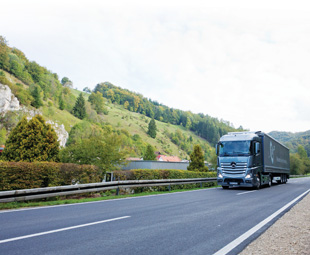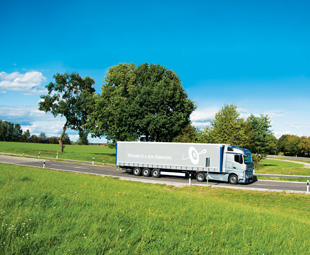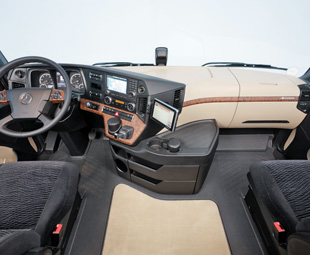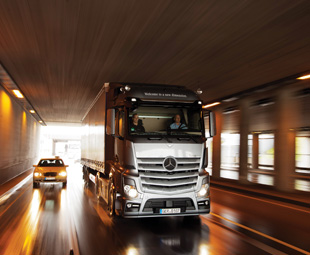New Actros: utterly awesome!

It’s October – which, in Munich, means Oktoberfest time (although serious doppers should note that this event actually kicks off in September). CHARLEEN CLARKE tosses her dirndl*, forsakes her beer, and gets behind the wheel of the much-lauded new Actros instead.
Munich rocks. I simply adore this fabulous city. It is ever so pretty, has lots to offer cultural boffins, it’s safe, the restaurants are great and … oh my cotton socks … the beer is just so yummy!
But, in my world, whenever I dash into Munich it’s normally at the invitation of two Bavarian companies – one a car and bike producer, the other a manufacturer of trucks and buses.
Not this time. I am indeed here to experience sheer driving pleasure – but in a truck. The über fantastic new Actros. Or so I have read.
However, as chuffed as I am to be in Munich and at a truck launch (…have I mentioned lately how much I adore my job?), the thought crosses my mind that perhaps I am becoming a tad cynical. Or maybe a tiny bit jaded. I have been to gazillions of truck launches and I am always told that they are “truly innovative”. That they “set new benchmarks”. Ya ya ya… I have been reading more of the same with the New Actros – and I suspect that it is mere marketing mumbo-jumbo.
This thought is top of mind as we arrive at Puma’s distribution centre in Munich, which is where our test drive will commence. But, on seeing the Actros in the metal, I am like an excited teenager about to go on her first date – with Brad Pitt nogal. That’s because the Actros is drop-dead gorgeous!
I know that this is not a key buying criterion for operators – truckers want a workhorse that will earn them big bucks. End of story. They don’t really care if it looks like a horse’s butt. But, having said that, the Actros is dead sexy.
Which is all very well. But what’s it like to drive? And how does it perform? After an extensive driver briefing (it takes 10 minutes just to explain the functionality of the key; I kid you not!) we are about to find out …
My first truck is the 1845 LS L-GigaSpace, equipped with the OM 471, a 330 kW (449 hp) motor. Euro-6 compliant, it displaces 12,8 litres and generates 2 200 Nm of torque. The gearbox is the 12-speed Mercedes PowerShift 3.
Before we leave, my driver takes 10 minutes to adjust my seat to the perfect position. And it really is perfect; I have precisely the right amount of lumbar support and I feel happily cosseted by the seat, which feels as though it is giving me a hug. We are only about to drive for one hour – in my world an hour hardly ever passes without food and so we are heading for lunch. But, truth be told, I would be quite happy to be driving for a day. Or a week, for that matter.
You will notice that I refer to “my driver”. Like every other South African truck magazine editor, I’m not crazy about the idea of driving on public roads in Europe. Some streets are awfully narrow – and we are obviously driving on the right-hand side of the road while the driver sits on the left of the truck. It’s a recipe for disaster, methinks.
It’s also not necessarily useful or productive. Sitting in the co-driver’s seat affords me the opportunity to examine the truck’s interior and spec levels.
 As stated, I am in the L-GigaSpace and … wow … it certainly is spacious. Even a giant would be able to walk through the cab without stooping and there is a whopping 2 050 mm of headroom in front of the driver’s seat.
As stated, I am in the L-GigaSpace and … wow … it certainly is spacious. Even a giant would be able to walk through the cab without stooping and there is a whopping 2 050 mm of headroom in front of the driver’s seat.
Something else that impresses me beyond belief is the level of luxury. I have been in limousines that pale into insignificance in comparison! It really is quite beautiful. The interior of this particular model is dressed in camel and black and it is ever so posh.
Equally impressive is the storage space. In fact, the stowage capacity totals 975 l – twice the luggage space available in a Mercedes-Benz C-Class. The outside flaps even open wide enough to stow away beverage crates. There are hidey-holes absolutely everywhere inside the cab! I could easily go on holiday for a fortnight in the new Actros. And trust me, being a girl I don’t travel light. Truck drivers must adore what is essentially their home away from home … because it doesn’t just look good, but is practical too.
One thing is certain: my driver absolutely adores the truck. He does not speak one word of English, but this does not stop him from demonstrating the many features – each of which is punctuated by a “wow” from me and a giggle from him. It’s obvious that he derives enormous delight and pride from being behind the wheel and, quite frankly, I don’t blame him.
My next truck is the 1845 LS L-Big Space, where I am in for a treat. Not only is the truck utterly magical, but I am joined by a test engineer named Benjamin Tomec. The extremely lucky young man, who has worked with Daimler and Mercedes-Benz since 1996, has a marvellous job. “I spend my life driving trucks – we do summer testing in the south of Spain, climbing 2 500 m up the Sierra Nevada. It reaches 38 or 40 ºC there. Winter testing takes place in the north of Finland at up to 40 ºC below,” he tells me.
It is evident that Tomec loves his job – and the new Actros. “We started working on this truck 10 years ago; this is the highlight of my career thus far,” the 31-year-old engineer reveals.
 As part of his job, Tomec has been driving with journalists from all over the world and they have all been very complimentary about the truck – even an Italian journalist. “Communication with him was hard. He spoke no German or English and I don’t speak Italian. But he kept pointing at features of the truck and saying ‘bello bello’. So I guess he really liked it,” says Tomec with a grin.
As part of his job, Tomec has been driving with journalists from all over the world and they have all been very complimentary about the truck – even an Italian journalist. “Communication with him was hard. He spoke no German or English and I don’t speak Italian. But he kept pointing at features of the truck and saying ‘bello bello’. So I guess he really liked it,” says Tomec with a grin.
I ask him about his favourite features of the new truck. “Gosh, that’s hard. It is such a special truck; I love everything about it. But I guess my favourite feature is the driving comfort. It is also a good working and living space; I feel relaxed in this truck when I am having a break. Oh, and I adore the quietness of the cab; this truck is really amazingly quiet,” Tomec point out.
He is spot-on. My previous driver had the radio blaring, so I failed to notice the level of refinement. We are doing 80 km/h on the autobahn and it is almost ominously silent in the cab – there is very little engine, road and wind noise. Just the sound of our voices; we are having a really nice, relaxing chat. “We have Adaptive Cruise Control (ACC) on now, so I’m doing nothing; I am just steering the truck,” Tomec points out.
The new Atros is especially advantageous to the driver who is perhaps slightly fatigued. ACC makes long highway stretches ever so easy, as the driver just sets the desired speed and then takes his foot off the accelerator. If he approaches slower-moving traffic, the truck will automatically slow down. When that traffic speeds up, the new Actros will automatically speed up too.
This feature was available in Actros 1, 2 and 3, but has been improved along the way. For instance, it’s now possible to see the speed of a vehicle travelling directly in front of you. It also works in slow-moving city traffic, which is a first – not only for the Actros, but for the entire industry.
 Tomec explains that this is especially useful in Germany. “The police pay a lot of attention to following distances on the autobahn. You lose points on your licence and you also have to pay a fine,” he explains.
Tomec explains that this is especially useful in Germany. “The police pay a lot of attention to following distances on the autobahn. You lose points on your licence and you also have to pay a fine,” he explains.
However he stresses that features like this will never replace the expertise of a good driver. “The driver remains invaluable. We are offering these systems for safety and security; we are not trying to replace the driver,” Tomec explains.
After a couple of hours of driving, we arrive in Ulm, a beautiful city on the Danube River which is famous for two things: a cathedral with the tallest steeple in the world; and being the birthplace of Albert Einstein.
Hartmut Nissle, head of strategic future truck program management at Daimler, addresses a press conference and tells us that 20 million test kilometres were completed prior to the launch of the new Actros. “I believe that this is unique in the development of commercial vehicles,” he comments.
He adds that the company did not aim for mediocrity. “It was our objective, from the beginning, to have a ground-breaking truck. We did not just want to meet Euro-6 standards. We focused on profitability, driving dynamics and comfort – and we set about setting the benchmarks in these particular areas,” Nissle reveals.
In order to achieve this, the new Actros reconciles high performance with low fuel consumption; its emissions are lower in pollutants than any comparable vehicle and it has undergone testing of unprecedented intensity.
Aerodynamics obviously played a vitally important role in achieving low fuel consumption. As such, the engineers subjected the Actros to 2 600 hours of intensive testing and optimisation in the wind tunnel. The design of the air deflectors on the roof, the roof itself, the front apron, the corner panelling and the cab-side extenders evolved with a meticulous attention to detail. Perforated slats on the radiator grille, a temperature-controlled radiator shutter, door leaves extended downwards, side panelling between front and rear axle – all these aspects underwent extensive testing in order to make the new Actros extremely economical.
 A second factor is engine technology and Nissle reveals that the engines are outstanding feats of engineering. “Two composite overhead camshafts with gear train and four valves per cylinder are just some of the distinguishing features. An outstanding attribute is the unique fuel injection technology based on a common rail system with pressure boost. A pressure of around 900 bar is generated in the rail. In the individual injectors, this pressure is boosted to as high as 2 100 bar. Injection timing point, injection quantity, injection pressure and the pressure characteristic are all variable. Equally innovative is charging of the engines via an exhaust gas turbocharger with asymmetric turbine casing. This method provides for improved response,” he explains.
A second factor is engine technology and Nissle reveals that the engines are outstanding feats of engineering. “Two composite overhead camshafts with gear train and four valves per cylinder are just some of the distinguishing features. An outstanding attribute is the unique fuel injection technology based on a common rail system with pressure boost. A pressure of around 900 bar is generated in the rail. In the individual injectors, this pressure is boosted to as high as 2 100 bar. Injection timing point, injection quantity, injection pressure and the pressure characteristic are all variable. Equally innovative is charging of the engines via an exhaust gas turbocharger with asymmetric turbine casing. This method provides for improved response,” he explains.
The driver plays a massive role when it comes to fuel consumption too, hence the decision to make FleetBoard standard. “The impact of FleetBoard cannot be overemphasised. It even helps those drivers who have undergone training, as the impact of this training is always lost after a couple of months. But FleetBoard is always there to give continual feedback,” he explains.
The second day kicks off at the former Mϋnsingen military test ground, which was built at the end of the 19th century for the 13th Royal Wϋrttembergian Army Corps. It fell under the control of the French after the Second World War and was subsequently abandoned in 2005. Today, this fabulous test facility is used extensively by car and truck manufacturers.
First of all, we will drive the current Actros – and then we get to try out the new Actros. Finally, it is to be my turn behind the wheel!
I am in the care of a very patient driver trainer called Michael, who is feeling a tad twitchy after spending time with an overly enthusiastic (but clearly challenged) journalist from Ireland who crashed the new unit – not just once, but twice!
I can see that he breathes a sign of relief as we travel through the 36 km test track, doing a slalom and lane change exercise en route. I’m not windgat; quite frankly, I just don’t see the point. Within a minute or two, Michael is chilling in the co-driver’s seat (initially he was hovering nervously, 1 cm from my right shoulder).
But then we hop into the new Actros and, I swear, my devil’s horns popped out. Whereas I was taking it easy in the current truck, the new vehicle feels so stable and the steering is very direct and car-like. It inspires confidence – and we whiz through the course at break-neck speed.
I comment to Michael that the PowerShift transmission is utterly brilliant (he agrees). The fully automatic 12-gear unit provides for fast gear-shifting with a precision which even the best driver cannot match. The transmission is operated by means of a steering column lever and supports the driver in diverse ways, with a choice of three driving programmes – Standard, Economy and Power – according to the demands of the given transport operations. A crawl function helps during manoeuvring, in much the same way as with an automatic transmission, while a rocking mode is useful on slippery surfaces. EcoRoll mode switches the transmission to neutral when appropriate, and subsequently engages the correct gear automatically, for maximum fuel economy in rolling phases.
The new Actros feels extremely stable – probably because the engineers incorporated a wider frame – and the chassis is noticeably stiffer. I’m especially impressed over a bumpy part of the circuit, where the ride is extremely smooth and comfortable. This is in part due to the air-suspension on the rear axle, which now operates with four air bellows and responds sensitively to uneven road surfaces, providing for optimum ride comfort while at the same time protecting the cargo.
The steering is far more precise and the brakes are so good that a passenger car would battle to keep pace in this department. I just love the ergonomic dashboard, which is just like a flight deck, and the start-stop button. The steering wheel adjustment is so much better and so much easier to use (a foot switch is depressed in order to adjust the multifunction steering wheel). Oh, and the seat! The safety belt is still integrated into the seat but now it is height adjustable. And the seat is just sensational. I especially love the built-in air-conditioning. And did I mention the massage function?
One other thing: the optional multifunction key, which can be used to do a pre-departure check. You navigate the menu much like the TV controls on an aircraft, and can do a light check via this key … simply activate the lights with the key and then walk around the truck. You can even check the tyre pressure and switch certain functions, such as air-conditioning, on and off.
Finally, the bad news. We will have to wait until 2014 or 2015 before the new Actros comes to South Africa – only because our fuel isn’t up to scratch.
What a pity …
* For the uninitiated, a “dirndl” is a traditional dress worn in Bavaria, Liechtenstein and Austria, based on the historical costume of Alpine peasants.
Published by
Focus on Transport
focusmagsa



